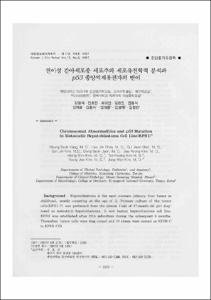KUMEL Repository
1. Journal Papers (연구논문)
1. School of Medicine (의과대학)
Dept. of Laboratory Medicine (진단검사의학)
전이성 간아세포종 세포주의 세포유전학적 분석과 p53 종양억제유전자의 변이
- Keimyung Author(s)
- Chun, Hyo Jin; Jeon, Dong Seok; Kim, Jae Ryong; Kim, Heung Sik; Kim, Dae Kwang
- Department
- Dept. of Laboratory Medicine (진단검사의학)
Dept. of Pediatrics (소아청소년학)
Dept. of Medical Genetics (의학유전학)
- Journal Title
- 대한임상병리학회지
- Issued Date
- 1997
- Volume
- 17
- Issue
- 6
- Abstract
- Background :Hepatoblastoma is the most common primary liver tumor in childhood, mostly occurring at the age of 2. Primary culture of the tumor cells(KPH1-P) was performed from the pleural fluid of 17-month-old girl diagnosed as metastatic hepatoblastoma. A new human hepatoblastoma cell line, KPH1 was established after 10th subculture during the subsequent 6 months. Thereafter, tumor cells were ring cloned and 10 clones were named as KPH1-C to KPH1-C10. Method :We investigated for the chromosomal abnormalities in the tumor cells from KPHFP, KPH1, and KPH1-C1 to KPH1-C10, respectively by cytogenetic analysis. Mutation of p53 gene was analysed by PCR-SSCP and direct sequencing. The status of p53, c-erbB-2, c-myc, K-ras and Hmras gene was also evaluated by Southern blot, along with PCR study for hepatitis B virus infection. Result :Primary culture cells, KPH1-P revealed a specific chromosomal aberration, such as t (1;12) (q21 ;q24), +i(1q), i(6p), and +8. The hepatoblastoma cell line, KPH1 and its clones, KPH1-Cl to KPH1-ClO, maintained the chromomsomal change of +1 (1q), i (6p), and +8, but there was a loss of t (1;12) (q21;q24) and a gain of t (7;16) (q21;pter). Southern blot of KPH1 revealed rearrange- ment of c-myc and c-erbB2. PCR-SSCP and direct sequencing for p53 in KPH1 showed point mutations at exon 8; codon 270, TTT + CTT; codon 287, GAG - TAT; codon 290, CGC - CAA; codon 291, AAG - AAT; codon 293, GGG -TAG; codon 297, CAC - AAC; codon 298; GAG - AAG. There was a loss of these gene rearrangements and p53 mutation in its clones, KPH1-Cl to KPH1-10. PCR for hepatitis B virus in KPH1 showed a specific band for the core region of HBV DNA, suggestive of HBV infection. Conclusion :In summary a new human hepatoblastoma cell line with 48, XX, +i(1q), i(6p), +8 and t (7; 16) (q2l;pter) was established. The change of chromosomal aberrations, and the loss of p53 mutation and rearrangement of c-myc and c-erbB2 in the process of long term culture is regarded as a secondary change for adaptation to the `in vitro` cultural environment, rather than a step of cancer progression. The identification of chromosomal break points and related altered genes in the established cell line, KPH1 might provide a useful guideline for studying carcinogenesis and progression of hepatoblastoma in future.
- Alternative Title
- Chromosomal Abnormalities and p53 Mutation in Metastatic Hepatoblastoma Cell Line(KPH1) *
- Publisher
- School of Medicine
- Citation
- 강명석 et al. (1997). 전이성 간아세포종 세포주의 세포유전학적 분석과 p53 종양억제유전자의 변이. 대한임상병리학회지, 17(6), 1157–1175.
- Type
- Article
- ISSN
- 1015-6445
- 파일 목록
-
-
Download
 oak-bbb-3414.pdf
기타 데이터 / 5.44 MB / Adobe PDF
oak-bbb-3414.pdf
기타 데이터 / 5.44 MB / Adobe PDF
-
Items in Repository are protected by copyright, with all rights reserved, unless otherwise indicated.